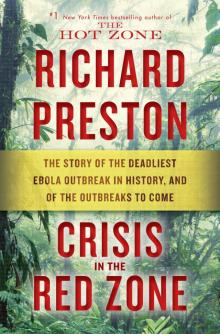- Home
- Richard Preston
Crisis in the Red Zone Page 5
Crisis in the Red Zone Read online
Page 5
THE WOMAN WITH ALMOND EYES
MELIANDOU
February–early March, 2014
The residents of Meliandou, Fabian Leendertz recalls, “really liked it when we came.” By the time they showed up, however, nobody in the village was sick. The virus had moved on. But the deaths had upset the villagers deeply, and they really wanted to find out where the disease had come from. The villagers helped Leendertz’s team trap bats and rodents so they could see if the virus had come from any of these animals. The villagers also shared a great deal of information about the way they hunted wild animals, about who had died in the village and when, and about their funeral practices.
Just before Leendertz and his team arrived in Meliandou, however, the bat tree somehow caught fire and burned. A large number of dead bats fell out of the tree during the fire, raining down through the hollow tree and landing on the ground around it. The villagers filled six rice sacks full of dead flying mice, cooked the bats more thoroughly, and ate them, despite the smell. Leendertz learned that nobody in the village had gotten sick from direct exposure to or eating the bats. This would suggest that the virus didn’t come from the bats. Or it would suggest that only a few of the bats carried the virus, while most of the bats did not. That is, the virus could be a rare disease of the bats, a disease that most of the bats never catch. Bats have their own rare diseases, of course, just as humans do. In any event, none of the rodents or other kinds of bats that the team members and villagers collected was carrying a deadly virus. In the end, Fabian Leendertz was never able to prove that bats or any other kind of creature had been the source of the disease. Nevertheless, he had a strong suspicion that the little boy had caught his illness from a bat. “We only have pieces of evidence, but there’s no proof,” Leendertz says.
In the months after its emergence in Meliandou, the disease kept spreading. In a village called Dandou, which is a fifteen-minute drive by motorbike from Meliandou, a man got sick. He was a relative of the midwife of Meliandou, the woman who’d died in the Guéckédou hospital after she’d taken care of Émile’s mother and grandmother. The man realized he was dying, and he asked his family to carry him into a patch of sacred forest. They placed him on the ground under the trees, where he died surrounded by his loved ones. Afterward, following local tradition, the man’s friends and family members took turns lying next to his body in the forest. They embraced the body, wept over it, and ate meals next to it during which they served foods that the man had liked. This was a way of remembering the man and cherishing their love for him. The disease attacked some of the mourners afterward.
In late February, in a village called Kpondu, in Sierra Leone, a woman in her thirties named Sia Wanda Koniono decided to travel to a city in Guinea called Kissidougou to visit her son. Kpondu village is a tiny group of houses situated only three hundred yards from the Makona River and the international border with Guinea. Ms. Koniono got across the river in a wooden pirogue poled by ferrymen. On the other side, in a bustling town in Guinea, she either hired a ride-share taxi or got on a jitney bus, which in that area is called a buda-buda. During the ride, she sat next to a passenger who was sick. Back in Kpondu village, after visiting her son in Guinea, Ms. Koniono came down with diarrhea and vomiting.
Her sickness got worse, and she sought medical help from a neighbor named Finda Nyuma. Finda Nyuma was a highly respected traditional healer. She was better known by her professional name, Menindor. Working as Menindor, Ms. Nyuma performed exorcisms and gave people medicinal compounds made from plants.
Menindor was a tall, impressive woman, a botanist with a deep knowledge of plants and the spirit world, and she was mysterious in her ways. She had almond-shaped eyes and a long face, and a gentle, enigmatic smile, and she covered her head with a lacework shawl. No one seemed to know Menindor’s exact age, but she was neither young nor particularly old.
We wouldn’t know about the existence of Menindor or any details about her if not for remarkable epidemiology and investigative reporting done by Dr. Sheri Fink and colleagues of hers at The New York Times, who traced the early spread of the virus in Sierra Leone. Menindor was a beloved figure in the villages along the Makona River. Many of her patients were women and young girls, and they came from villages far away to be healed by Menindor. The local people believed that Menindor kept a powerful snake in a chest in her house. This was no ordinary snake, but a supernatural being.
Ms. Koniono, sick after her trip in Guinea, got treatment from Menindor, but her vomiting and diarrhea continued. Finally her relatives decided to take her to the city of Guéckédou, in Guinea, where her brother lived, for medical treatment at the Guéckédou hospital. The city is ten miles from Kpondu village. She started throwing up blood in the hospital, and she died there on March 3. Her family intended to have her buried in Sierra Leone. It is traditional for women to prepare a body for burial. Five of Ms. Koniono’s sisters washed her body. Following the usual practice, they gave the body a kind of enema, which purged the contents of the bowels and cleansed the body internally. This is something important to do in a tropical climate, or the body deteriorates rapidly. Then they poured clean water over the body. Ms. Koniono’s body was brought back to Kpondu village. A day later, her relatives took her body to a spot a few miles away, and gave her a burial.
In the following weeks, in Guinea, all five of Ms. Koniono’s sisters reportedly died. In Kpondu, Sierra Leone, Menindor was seeing more patients with the illness, and many of them were women and girls. She tried all her medical arts, all her secret weapons, but nothing seemed to work.
IDENTIFICATION
KENEMA GOVERNMENT HOSPITAL, SIERRA LEONE
March 13, 2014
Kenema is a small city, with a population of about 180,000, which sits at the feet of the Kambui Hills in eastern Sierra Leone. The Kambui Hills, long whalebacks covered with tropical forest, rise to the west of the city and look down on a maze of metal roofs and dirt streets. The countryside around Kenema is a hilly expanse of green that is dotted with villages and small towns. The communities are nestled among cassava and rice fields and patches of forest, and groves of oil palms, and stretches of thick farmbush. The soil is tawny orange and not terribly fertile, and the land is dissected by sandy streams and swamps. The sand contains diamonds. These days, freelance diamond miners can be seen working along just about every stream and watercourse around Kenema, sifting sand and mud through sieves and searching it for diamonds. Recently a Christian pastor who was sifting a stream to the north of Kenema found a yellow diamond the size of a lemon. Kenema is about a hundred miles by road from Kpondu, Sierra Leone, the village where Menindor the healer lived. The drive from Kenema to Kpondu takes five to six hours, and most of it is over rugged dirt roads.
The catchment hospital for the region is Kenema Government Hospital, a sprawling collection of low pavilions, linked by covered walkways and dirt roads, surrounded by a high wall, in the center of Kenema. Toward the middle of March, while Menindor was trying to heal sick patients in her village, a medical doctor and virologist at Kenema Government Hospital named Humarr S. Khan began receiving reports that a hemorrhagic fever had broken out in Guinea near the border with Sierra Leone.
Humarr Khan was then the chief physician of the Lassa Fever Research Program at Kenema Government Hospital. He was a virologist who specialized in Lassa hemorrhagic fever, which is a devastating and frequently fatal disease caused by Lassa virus, a Biosafety Level 4 virus that invades the brain and causes hemorrhagic bleeding. BSL-4 viruses, or Level 4 viruses, are sometimes referred to as hot agents. They are lethal, highly infective viruses for which, in almost all cases, there is no vaccine, no cure, and no effective treatment. If you catch a Level 4 virus, there is very little any doctor can do for you other than keep you hydrated and prevent you from having any contact with anyone else. In many countries, including in the United States, regulations require researchers who are handling Level 4 viruses
to wear a whole-body pressurized biohazard space suit with an independent, filtered air supply. In addition, the space-suit research must be conducted inside a Biosafety Level 4 laboratory. A Level 4 lab is sometimes called a hot lab, a hot suite, or a hot zone. It is a group of rooms that are sealed off from the outside world and are only accessible through an airlock that is equipped with steel doors and a chemical shower. The shower is used for decontaminating the space suits of researchers when they make an exit from the hot zone.
The Lassa research program at Kenema Government Hospital is dedicated to giving care to Lassa patients, to tracing and stopping outbreaks of Lassa fever in the countryside, and to pursuing research on the virus in the hope of someday eliminating the disease. The program consists of a small high-biocontainment hospital unit, called the Lassa Fever Isolation Ward, a tiny group of offices, and a building called the Lassa Laboratory, inside which is a sealed, high-biocontainment laboratory known as the Hot Lab.
In the Hot Lab, the staff and scientists of the Lassa program wear high-biosecurity personal protection equipment, or PPE. A complete set of PPE gear amounts to a kind of nonpressurized space suit. It consists of a whole-body protective suit made of Tyvek (an impermeable fabric); a high-efficiency breathing mask called a HEPA mask, which can filter virus particles from the air; a transparent face shield or goggles; rubber gloves; and heavy rubber boots.
When Humarr Khan heard about a hemorrhagic disease breaking out in Guinea, he immediately suspected it was Lassa hemorrhagic fever. In addition to being a Biosafety Level 4 hot agent, Lassa virus is classified as an emerging virus. That is, the virus is making cross-species jumps out of nature into humans, and it is currently expanding its geographic range. The virus exists naturally in a certain kind of wild rat that lives in parts of West Africa. People come into contact with the rats, and the virus then jumps from a rat into a person. Once it gets into a person, Lassa virus can travel directly from person to person through contact with blood and body fluids.
Lassa attacks the brain and major organs, and it causes a polymorphic disease—one that takes different forms in different people. Some people who catch Lassa get a headache that lasts for about two weeks, and then the virus goes away—the person recovers fully.
Other people break with Lassa hemorrhagic fever. In these cases, the virus destroys the brain and causes failure of major organs. Lassa patients can have hemorrhagic nosebleeds, as well as bleeding from the mouth, eyes, and kidneys. They develop a swollen face; their hair can fall out; they develop a deadened, masklike facial expression; they can have seizures; they can fall into a coma that ends with an irreversible breathing arrest.
Lassa virus is thought to infect around 300,000 people a year in West Africa. It’s not clear how many people die of Lassa hemorrhagic fever each year, but the fatalities certainly number in the thousands. Many of them are pregnant mothers and their unborn children. The Lassa program in Kenema is funded by the government of Sierra Leone and a consortium of research institutions around the world, including Tulane University, Harvard, and the Scripps Research Institute. Humarr Khan had many friends and colleagues at these institutions. When he learned that a viral hemorrhagic fever was spreading in Guinea, he got in touch with some of his international colleagues to let them know about the outbreak, and he told them he would keep them posted on any developments. Khan was anticipating the arrival of many Lassa patients in his ward. He was seeing, he suspected, a big emergence of the virus from the wild rats.
BRUSSELS, LYON, GENEVA
March 13–21
In Brussels, Belgium, in a brick building on the Rue Dupré, managers at Médecins Sans Frontières, or Doctors Without Borders, a large international medical relief organization, were also receiving worrisome reports that a viral hemorrhagic fever had broken out in Guinea. The Brussels office of Doctors Without Borders is an operational center of the organization. The managers there quickly arranged for an investigation in Guinea. On March 13, a combined team of epidemiologists from Doctors Without Borders and the government of Guinea set out from Conakry, the capital of Guinea, in four-wheel-drive vehicles, to see what was going on in the Triangle. By this time, two and a half months had passed since the death of the little boy in Meliandou.
The team visited the hospital in Guéckédou, met with local health officials, and identified people with the illness. They also collected samples of patients’ blood. The blood was sent by air to the Jean Mérieux-Inserm Laboratory, in Lyon, France, and to the Bernhard Nocht Institute for Tropical Medicine, in Hamburg, Germany. The French lab in Lyon is a Biosafety Level 4 facility, where scientists wearing biohazard space suits conduct research on Level 4 hot agents. There, a virologist named Delphine Pannetier, along with colleagues who included a virologist at the Pasteur Institute in Paris named Sylvain Baize, began working to identify the infectious agent in the blood samples from Guinea.
By the early hours of the morning on March 21, the French scientists were sure that the agent in the blood was a filovirus. The filoviruses are a family of viruses that all look alike, and most of them are extremely lethal. Sylvain Baize immediately sent an email to the headquarters of the World Health Organization, in Geneva, Switzerland, announcing it was a filovirus. But, so far, the French and German teams couldn’t tell what kind of a filovirus it was. They continued working at a frantic pace, trying to nail down the identity of the virus that was emerging in West Africa. The French investigators had learned that some of the patients had had hiccups. This detail really caught their attention. Hiccups are a classic sign of Ebola virus disease.
LISA HENSLEY
FREDERICK, MARYLAND
Before sunrise, March 21, 2014
Eight hours after the French scientists identified the agent in the blood samples from West Africa as a filovirus, a virologist named Lisa Hensley was in an upstairs bedroom in her house, in Frederick, Maryland, pedaling a stationary bike. It was early in the morning, still dark. An icy, raw morning. As she pedaled, she took up her phone and began paging through emails and tapping out replies. At 5:48 a.m., an email from a colleague caught her attention: He was asking if she knew anything about an unidentified hemorrhagic fever virus in Guinea.
She typed while she pedaled: “Hearing it is Ebo. Don’t know more yet—Info is confidential.”
She finished her workout, showered, and got dressed. Spring was supposed to be on its way, but this morning was pure winter. She put on tights, a skirt, a sweater, loafers with block heels. Lisa Hensley has greenish-brown eyes and chiseled features, and brown, straight hair, which is lightened and cut so that it falls in curves along her cheekbones. She put on a small amount of makeup, and decided to wear her silver hoop earrings.
It was time to wake up her son. She went into his bedroom and looked up toward the ceiling. James slept on a platform bed above his desk. “Time to get up, sweetie.”
There was a stirring near the ceiling, and eventually James’s face appeared over the edge of the bed, looking down at her, his hair more moplike than usual. She guessed that he’d stayed up late surfing the Internet or playing games on his laptop.
James climbed down the ladder and started putting on his clothes, while she went back into her room. After a little while, she heard: “Mom, carry me downstairs.” She went back into his room, and he jumped up on her back, and she piggybacked him down to the kitchen.
James had hemophilia, an inherited disease that causes the blood to fail to clot normally. A hemophiliac can bleed endlessly from a small cut, and can have dangerous internal bleeding after getting a blow to the head or body. James’s hemophilia was mild and easily treatable, but when he had been a baby Hensley had decided to carry him up and down stairs to prevent him from taking a fall on the stairs, especially when he was learning to walk. Now, at age nine, he was an active, healthy, athletic boy. He went up and down the stairs all the time, except that she still carried him downstairs in the morning and upstairs to bed at
night. It had become sort of a tradition, and they both liked it.
She dropped him off at school, and then drove to Fort Detrick. Cactoctin Mountain was a gray shape rising behind the Army base. The trees on the mountain were still bare, and under the rainy sky they looked more like smoke clinging to the mountain than trees. She drove through a security gate onto the base and parked next to the National Interagency Biodefense Campus. The campus consists of a group of buildings near the center of Fort Detrick. All but one of the buildings on the Biodefense Campus are starkly new.
Hensley went through a checkpoint into the campus and walked toward an L-shaped building called the Integrated Research Facility, or IRF. The IRF had just been completed, after nine years of construction. The facility is part of the National Institute of Allergy and Infectious Diseases, which in turn is a part of the National Institutes of Health, or NIH. The IRF’s mission is to develop experimental drugs and vaccines, called medical countermeasures, that could defeat lethal emerging viruses and advanced biological weapons. Lisa Hensley had recently been appointed an associate director of the IRF. She was in charge of all of the scientific research programs at the facility. It was her job to manage all the IRF’s research into the world’s most dangerous viruses. She was new on the job, having started working at the IRF just two months earlier.
One wing of the IRF is faced with glass and resembles a fish tank, while the other wing is a brick-faced monolith, without too many windows in it, known as a biocontainment block. The block contains Biosafety Level 4 laboratories, where researchers investigate the most dangerous viruses on the planet. The IRF is the most advanced Biosafety Level 4 research facility in the world, and it is a crown jewel of the National Institutes of Health.

 The Demon in the Freezer
The Demon in the Freezer Panic in Level 4: Cannibals, Killer Viruses, and Other Journeys to the Edge of Science
Panic in Level 4: Cannibals, Killer Viruses, and Other Journeys to the Edge of Science The Cobra Event
The Cobra Event The Hot Zone
The Hot Zone Crisis in the Red Zone
Crisis in the Red Zone First Light: The Search for the Edge of the Universe
First Light: The Search for the Edge of the Universe The Book of the Dead
The Book of the Dead Panic in Level 4
Panic in Level 4